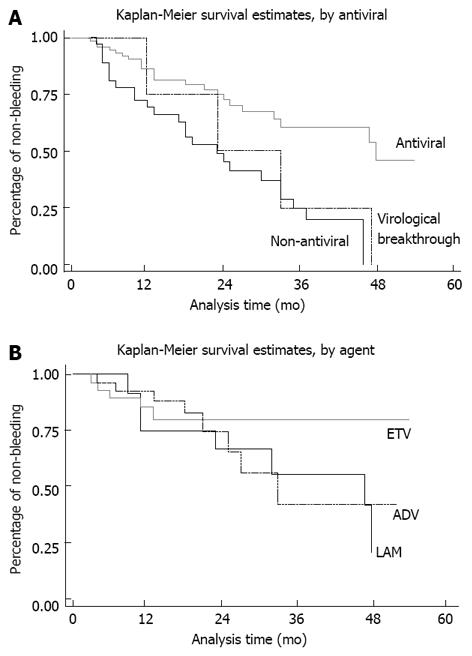Copyright
©2013 Baishideng Publishing Group Co.
World J Gastroenterol. Oct 28, 2013; 19(40): 6849-6856
Published online Oct 28, 2013. doi: 10.3748/wjg.v19.i40.6849
Published online Oct 28, 2013. doi: 10.3748/wjg.v19.i40.6849
Figure 1 Kaplan-Meier analysis of non-bleeding duration.
A: Non-bleeding duration in antiviral and control cases was compared using the Kaplan-Meier survival model. Bleeding was defined as a failed event. The occurrence of bleeding was reduced and delayed in the antiviral treatment group compared to the control group. The curve of virological breakthrough cases (dashed line) was close to that of the control group, demonstrating reduced efficacy when virological breakthrough occurred; B: Non-bleeding durations for entecavir (ETV), adefovir (ADV) and lamivudine (LAM) therapy were compared using the Kaplan-Meier survival model. Bleeding was defined as a failed event. The non-bleeding durations for ETV, ADV and LAM were similar in the first 2 years, however, differences became clear following long-term treatment, which may have been due to cumulative resistance and bleeding.
Figure 2 Sketch of delayed progression of esophageal varices by antiviral therapy.
Varices were scored according to the criteria of the Japanese Association of Portal Hypertension: grade I, II, and III and given a score of 1, 2 and 3, respectively. Bleeding was scored as 4. Endoscopic eradication was scored as 0. The dark line shows the development of esophageal varices in hepatitis B virus-related cirrhosis without antiviral therapy. The dashed line is the development of varices with antiviral therapy. The grade of esophageal varices increases with time and then bleeding occurs. After endoscopic eradication, the varices score increases again until bleeding recurs. Antiviral therapy delayed both the progression of varices before and after endoscopic therapy and postponed esophageal variceal bleeding. Before endo: Before endoscopic intervention; After endo: After endoscopic intervention.
- Citation: Li CZ, Cheng LF, Li QS, Wang ZQ, Yan JH. Antiviral therapy delays esophageal variceal bleeding in hepatitis B virus-related cirrhosis. World J Gastroenterol 2013; 19(40): 6849-6856
- URL: https://www.wjgnet.com/1007-9327/full/v19/i40/6849.htm
- DOI: https://dx.doi.org/10.3748/wjg.v19.i40.6849










